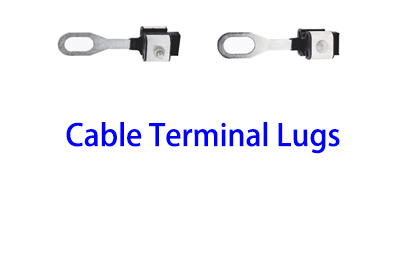Cable terminal lugs are vital for ensuring the reliable operation of electrical systems. However, like any electrical component, they can develop faults over time. Detecting and repairing these faults promptly is crucial to prevent system failures, electrical hazards, and costly downtime.

Ⅰ.Fault Detection Methods
⒈Visual Inspection
External Appearance: Start with a visual examination of the cable terminal lugs. Look for signs of physical damage such as cracks, deformation, or corrosion on the lug body. Corrosion, especially in humid or corrosive environments, can be a significant issue. Greenish - blue deposits on copper lugs indicate copper oxidation, while white or grayish - white deposits on aluminum lugs suggest aluminum corrosion. These corrosive layers can increase electrical resistance and lead to connection problems.
Cable and Lug Connection: Check the connection between the cable and the lug. Ensure that the cable is properly inserted into the lug and that there are no signs of the cable pulling out or being loose. Loose connections can cause intermittent electrical contact, leading to arcing and overheating.
⒉Electrical Testing
Resistance Measurement: Use a digital multimeter set to the resistance measurement mode to check the resistance of the cable - lug connection. A high - resistance reading compared to the expected value (which can be found in the manufacturer's specifications or determined by measuring a known - good connection) indicates a problem. High resistance can be caused by factors like corrosion, a loose connection, or damage to the conductive material of the lug. For example, in a low - voltage DC circuit, if the normal resistance of a cable - lug connection is around 0.01 ohms, but the measured value is 0.1 ohms or higher, it's a strong indication of a fault.
Voltage Drop Test: In a live electrical system, a voltage drop test can be performed. Measure the voltage across the cable terminal lug while current is flowing through the circuit. According to Ohm's Law ( ), a significant voltage drop across the lug ( ) indicates a high - resistance connection (since and is the current flowing through the circuit). A voltage drop that exceeds the acceptable limit specified by the relevant electrical standards or the equipment manufacturer may lead to inefficient power transfer and overheating.
⒊Thermal Imaging
Overheating Detection: Thermal imaging cameras can be used to detect temperature differences in the cable - lug connections. During normal operation, the temperature of the cable terminal lugs should be close to that of the surrounding components. If a lug is overheating, it indicates a problem, such as a high - resistance connection. Overheating can be a precursor to a complete failure, and thermal imaging allows for early detection, even in hard - to - reach areas. For instance, in a large industrial switchgear where multiple cable terminal lugs are used, a thermal imaging scan can quickly identify any overheating lugs, enabling proactive maintenance.
Ⅱ.Common Faults and Repair Methods
⒈Loose Connections
Cause: Loose connections can occur due to vibrations in the electrical system, improper installation, or thermal expansion and contraction over time.
Repair: If the connection is loose, first, turn off the power supply to the circuit for safety. For crimp - type lugs, use a proper crimping tool to re - crimp the lug onto the cable, ensuring a tight fit. For bolted lugs, use a torque - wrench to tighten the bolts to the recommended torque value specified by the manufacturer. This ensures that the connection is secure and can withstand mechanical stress.
⒉Corrosion
Cause: Exposure to moisture, chemicals, or harsh environmental conditions can cause corrosion on cable terminal lugs.
Repair: If the corrosion is mild, use a wire brush or sandpaper to gently remove the corrosive layers. For copper lugs, a mixture of vinegar and salt can be used to clean the corrosion, followed by thorough rinsing with water and drying. After cleaning, apply an anti - corrosion compound or a layer of conductive grease to protect the lug from further corrosion. In cases of severe corrosion where the lug's integrity is compromised, the damaged lug should be replaced with a new one.
⒊Damaged Lugs
Cause: Physical damage to the cable terminal lugs can result from mechanical stress, improper handling during installation, or external impacts.
Repair: If the damage is minor, such as a small scratch or dent that does not affect the electrical or mechanical performance significantly, the lug can be carefully inspected and, if deemed safe, can be reused after ensuring that the connection is still secure. However, for more severe damage, like a cracked or broken lug, the damaged lug must be replaced with a new one of the correct size, material, and specification.
In conclusion, regular inspection and effective fault - detection methods are essential for maintaining the integrity of cable terminal lugs. By promptly identifying and repairing faults, the reliability and safety of electrical systems can be ensured, minimizing the risk of electrical failures and associated hazards.
GET A QUOTE